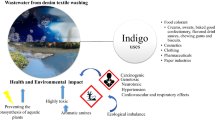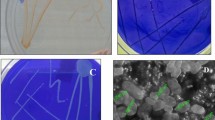Abstract
The bacterium, Kocuria kristinae RC3 capable of decolorizing sulfonated azo dye, amido black 10B was isolated using enrichment technique and identified by 16s rRNA gene sequencing. A maximum decolorization of 74.19% was achieved in the mineral salt medium at 37 °C and 24 h of incubation time. Effect of medium components and process conditions on decolorization efficiency was studied using response surface methodology involving a central composite design. Further, the interactions between the process conditions, i.e., pH, temperature, cell mass, dye concentration, and medium components, i.e., glucose, yeast extract, K2HPO4 and (NH4)2SO4 concentration were modeled and investigated. The predicted values were found to be in good correlation with experimental values. The process conditions were optimized which resulted in 93.0% dye decolorization by the bacteria in 24 h. The optimized process conditions for maximum decolorization of amido black 10B by the bacterium were pH (7.4), cell mass (2.9 g/L), temperature (35.3 °C) and dye concentration (137.46 mg/L) in 24 h. The optimal medium conditions for maximum decolorization determined by RSM were glucose (3.17 g/L), yeast extract (1.05 g/L), K2HPO4 (1.66 g/L) and (NH4)2SO4 (1.06 g/L). Under these conditions, maximum decolorization of 96.83% was achieved in 24 h. The results demonstrated that K. kristinae RC3 could be employed for the treatment of amido black 10B contaminated wastewater/effluents.





Similar content being viewed by others
References
Angelova R, Baldikovad E, Pospiskova K, Maderova Z, Safarikova M, Safarik I (2016) Magnetically modified sheaths of Leptothrix sp as an adsorbent for amido black 10B removal. J Magn Magn Mater 427:314–319
Ayed L, Bakir K, Ben Mansour H, Hammami S, Cheref A, Bakhrouf A (2017) In vitro mutagenicity, NMR metabolite characterization of azo and triphenylmethanes dyes by adherents bacteria and the role of the “cna” adhesion gene in activated sludge. Microb Pathog 103:29–39
Chaieb K, Hagar M, Radwan NRE (2016) Biodegradation and decolorization of azo dyes by adherent Staphylococcus lentus strain. Appl Biol Chem 59(3):405–413
Chengalroyen MD, Dabbs ER (2013a) Identification of a gene responsible for amido black decolorization isolated from Amycolatopsis orientalis. World J Microbiol Biotechnol 29(4):625–633
Chengalroyen MD, Dabbs ER (2013b) The microbial degradation of azo dyes: minireview. World J Microbiol Biotechnol 29:389–399
Chung KT (2016) Azo dyes and human health: a review. J Environ Sci Health C Environ Carcinog Ecotoxicol Rev 34(4):233–261
Couto SR (2009) Dye removal by immobilised fungi. Biotechnol Adv 27(3):227–235
Cui D, Li G, Zhao M, Han S (2014) Decolourization of azo dyes by a newly isolated Klebsiella sp strain Y3, and effects of various factors on biodegradation. Biotechnol Biotechnol Equip 28(3):478–486
Franciscon E, Zille A, Dias GF, Ragagnin MC, Durrant LR, Cavaco-Paulo A (2009) Biodegradation of textile azo dyes by a facultative Staphylococcus arlettae strain VN-11 using a sequential microaerophilic/aerobic process. Int Biodeter Biodegrad 63:280–288
Jadhav SB, Surwase SN, Phugare SS, Jadhav JP (2013) Response surface methodology mediated optimization of remazol orange decolorization in plain distilled water by Pseudomonas aeruginosa BCH. Int J Environ Sci Technol 10:181–190
Khan R, Bhawana P, Fulekar MH (2013) Microbial decolorization and degradation of synthetic dyes: a review. Rev Environ Sci Biotechnol 12:75
Mahmood R, Sharif F, Ali S, Hayyat MU (2015) Enhancing the decolorizing and degradation ability of bacterial consortium isolated from textile effluent affected area and its application on seed germination. Sci World J 2015:628195
Mittal A, Thakur V, Gajbe V (2013) Adsorptive removal of toxic azo dye amido black 10B by hen feather. Environ Sci Pollut Res 20:260
Mohana S, Shrivastava S, Divecha J, Madamwar D (2008) Response surface methodology for optimization of medium for decolorization of textile dye direct black 22 by a novel bacterial consortium. Bioresour Technol 99(3):562–569
Qu Y, Shi S, Ma F, Yan B (2010) Decolorization of reactive dark blue K-R by the synergism of fungus and bacterium using response surface methodology. Bioresour Technol 101:8016–8023
Selvam K, Swaminathan K, Chae KS (2003) Decolourization of azo dyes and a dye industry effluent by a white rot fungus Thelephora sp. Bioresour Technol 88(2):115–119
Senthilkumar S, Perumalsamy M, Prabhu HJ (2011) Decolourization potential of white-rot fungus Phanerochaete chrysosporium on synthetic dye bath effluent containing amido black 10B. J Saudi Chem Soc 18(6):845–853
Singh RP, Singh PK, Singh RL (2014) Bacterial decolorization of textile azo dye acid orange by Staphylococcus hominis RMLRT03. Toxicol Int 21:160–166
Sun JH, Sun SP, Wang GL, Qiao LP (2007) Degradation of azo dye Amido black 10B in aqueous solution by Fenton oxidation process. Dyes Pigments 74(3):647–652
Xia S, Zhang Z, Wang X, Yang A, Chen L, Zhao J, Leonard D, Jaffrezic-Renault N (2008) Production and characterization of a bioflocculant by Proteus mirabilis TJ-1. Bioresour Technol 99:6520–6527
Yang XQ, Zhao XX, Liu CY, Zheng Y, Qian SJ (2009) Decolorization of azo, triphenylmethane and anthraquinone dyes by a newly isolated Trametes sp SQ01 and its laccase. Process Biochem 44(10):1185–1189
Acknowledgements
The authors acknowledged the management of Kalasalingam University for facility provided. The authors thank to Dr. T. Sathish, Project Scientist, National Institute of Ocean Technology (NIOT), Port-Blair, Andaman & Nicobar Islands, India, for supporting the optimization experiments using Response surface methodology.
Author information
Authors and Affiliations
Corresponding author
Additional information
Editorial responsibility: Rupali Datta.
Rights and permissions
About this article
Cite this article
Uppala, R., Sundar, K. & Muthukumaran, A. Response surface methodology mediated optimization of decolorization of azo dye amido black 10B by Kocuria kristinae RC3. Int. J. Environ. Sci. Technol. 16, 4203–4214 (2019). https://doi.org/10.1007/s13762-018-1888-3
Received:
Revised:
Accepted:
Published:
Issue Date:
DOI: https://doi.org/10.1007/s13762-018-1888-3




